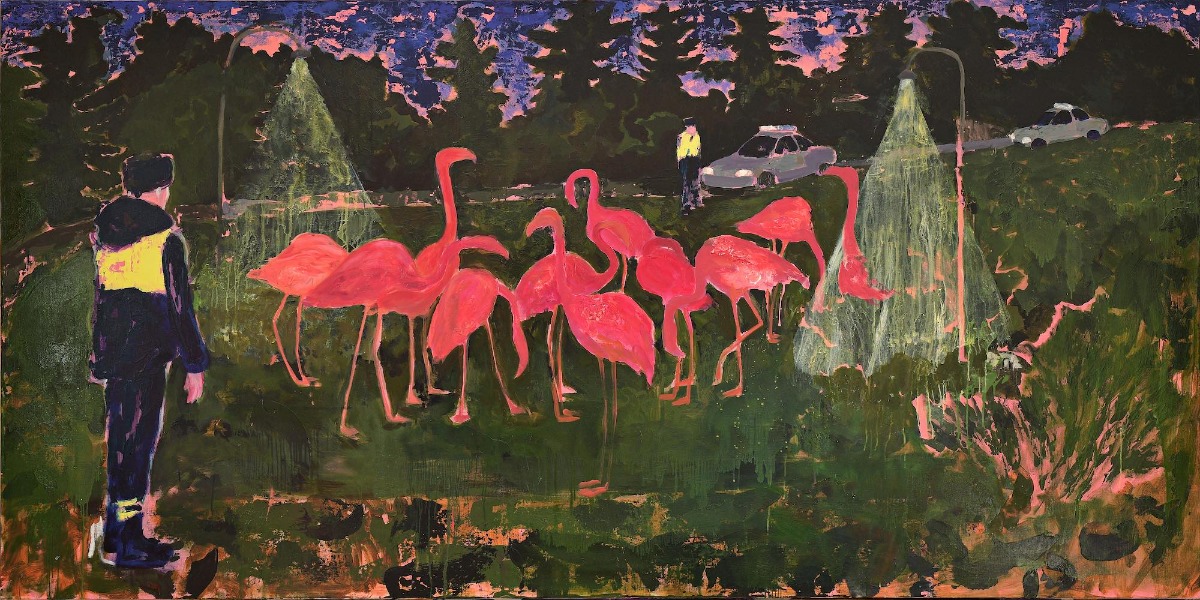
The World Around Us As a Boundless Collage
An express interview with Kristina Romanova, the curator for the Consciousness Doesn’t Have Borders exhibition at the Winzavod Center for Contemporary Art in Moscow. It is open until September 27.
The exhibition Consciousness Doesn’t Have Borders brings together the works of two young contemporary artists: Yulia Virko and Anthony Gelfand. As it is outlined in the dedicated press release, “in their first solo exhibition in Moscow, large-scale paintings and drawings created by Virko are presented alongside photo collages and videos by Gelfand in a multi-faceted installation.”
The title Consciousness Doesn’t Have Borders refers to the exhibition's fragmented character and how it correlates and interacts with the complexity of human consciousness.
Yulia Virko’s paintings are created according to the laws of dreams and the unconscious, where the truth comes along with fiction: a flamingo walking under police surveillance, or a huge iceberg in raspberry water. Anthony Gelfand uses family archives and found objects in his works. Children’s toys, jewellery and household collectibles become the material for creating still life photographs, objects of art, and video collages.
Anthony Gelfand. Fire and Ice. Digital print on photo paper, 2020
A labyrinth in the White Hall industrial space, invented by architect Ksenia Lukyanova, was assembled with bright metal modules to offer the spectator several alternative routes to explore. That allows the two young artists to show their works as a single project at other exhibition venues in the future.
We contacted Kristina Romanova (Research Arts), the exhibition’s curator for an express interview.
Yulia Virko. 209.128. Acrylic on canvas, 2019
How did the idea to exhibit these two artists come together? Was it due to the fact that both Virko and Gelfand completed their degrees as artists in the US?
Well, both Yulia Virko and Anthony Gelfand studied at the Savannah College of Art and Design, however, that was not the determining factor. First and foremost, we’re presenting their works together due to these artists having a close artistic bond. Yulia and Anthony have been friends for years; they used to exhibit their works together before. When Anthony’s canvases required some restoration after being transported, Yulia actually helped him restore his paintings.
I wouldn’t necessarily call them an artistic duo, but they are definitely two artists whose methods, general approach, themes and backgrounds are very similar.
Primarily, this was a project implemented by two artists. This is not Yulia Virko’s or Anthony Gelfand’s solo exhibition; it is a single exhibition, united in its name, concept and architecture, where the viewer absorbs the works around them as they move from one artist to another. With the title of the exhibition, I actually mean that with her works, Yulia immerses the audience in the unconscious and imaginary, while Anthony's works are more about consciousness itself, about the source of imagination and where it comes from.
The exhibition “Consciousness Doesn't Have Borders” in the White Hall at CAA Winzavod


To what extent do you think the Consciousness Doesn’t Have Borders exhibition complies with the definition of “total installation”?
“Total installation” is actually how we truly approached this exhibition. It is rooted in the exhibition’s architecture. It also ties in with the title for this project; it is as if you find yourself inside the artists’ consciousness, wandering and exploring. Architecture and the labyrinth itself become one of the most important components for the exhibition. If the works would have been shown differently, the whole concept of the exhibition would change as well.
Anthony Gelfand. I Normally Drink Vegetable Juice During Business Hours. Digital print on photo paper, 2020
“The exhibition’s fragmented character correlates with the complexity of human consciousness”. Is it possible to say that layering and collaging (which, as mentioned in the exhibition profile, is a common method for both artists) is still an adequate way to convey our understanding of the world around us?
Layering, collaging, and the artists’ way of using mixed media – combining photography and video, ink and acrylic – is not only a method but a conceptual decision as well. It seems to me that our whole world is one big collage. This is especially applicable to the information that we receive every second – what remains in our minds and in our smartphones.
Given the acceleration of time inherent in our era, we all find ourselves in a situation where events and impressions pass us by too quickly. We can easily cross territorial boundaries, wake up in one country and fall asleep in another, absorb a huge amount of information like a sponge, including visual images, within just a day. Hence, this collage, which inevitably finds itself inside our minds.
This volume of information becomes a new source of material for the artists’ works. This is how their paintings, photographs and videos are created. For example, Yulia told me that her imaginary worlds, which she explores in her paintings and drawings, come from ordinary images she absorbs everyday.
Yulia Virko. 238.215. Acrylic on canvas, 2020
The exhibition will not only be shown in Moscow. What are the plans for it and where will it exhibit next?
Consciousness Doesn’t Have Borders is open until 27 September in the White Hall of Winzavod Center for Contemporary Art. The architecture, which was realized by Ksenia Lukyanova, can be adapted to any exhibition space since the number of rooms and the structure of the labyrinth can be changed. In the middle of October, this exhibition will travel to St Petersburg’s Sevkabel Port. Then we have plans to exhibit in Nizhny Novgorod, Kazan, and Astrakhan. With each exhibition space during this tour, the works will be shown in a new way. Some of the works will stay with collectors, other artworks will appear for the very first time. The exposition is very lively, and with the idea that “consciousness doesn’t have borders”, it allows us to be that flexible with both the works and the architecture.
Picture at the top: Yulia Virko. 20.255. Acrylic on canvas, 2020